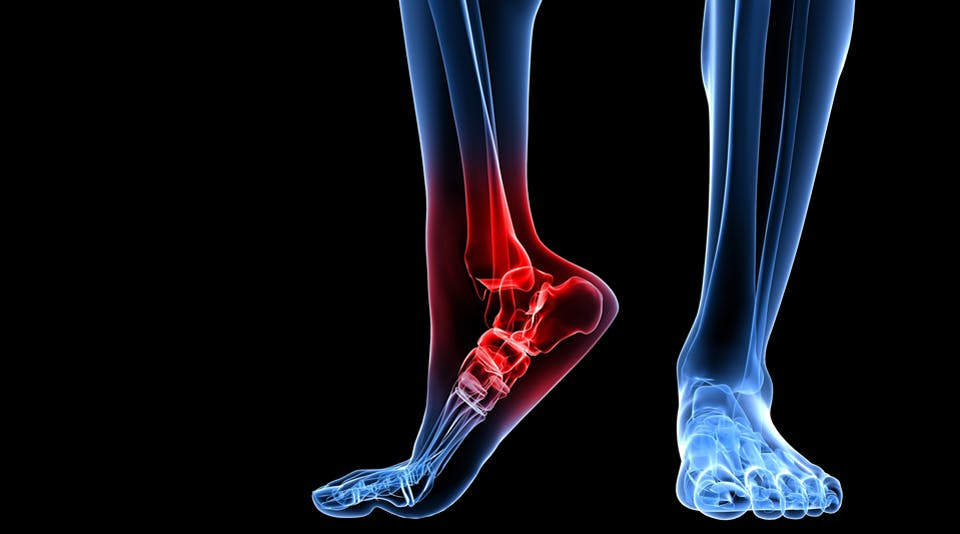
Osteoarthritis of the Ankle
Osteoarthritis of the ankle is a degenerative condition that causes pain, stiffness, and swelling due to the gradual wearing away of the protective cartilage within the ankle joint.
Overview
What is it?
Osteoarthritis (OA) is often called "wear and tear" arthritis. In a healthy ankle, the bone ends are coated with smooth articular cartilage that allows them to glide friction-free. In OA, this cartilage thins and wears away, eventually leading to "bone-on-bone" contact. The joint may produce extra bits of bone (osteophytes or "bone spurs") in an attempt to heal itself, which further restricts movement.
How common is it?
While less common than hip or knee osteoarthritis in the general population, it is still a frequent cause of ankle pain, particularly in people who have experienced previous trauma to the joint.

Symptoms & Causes
What are the symptoms?
The primary symptoms are pain and stiffness in the ankle joint. You may notice swelling around the joint, a grinding sensation (crepitus) when moving the foot up and down, and a progressive loss of flexibility.
What does it feel like?
Patients often describe a deep, aching pain that is worse when weight-bearing and improved by rest. The ankle often feels stiff and "rusty" first thing in the morning or after sitting for a while, taking a few minutes to "loosen up" when you start walking.
What causes it?
Unlike knee or hip OA, which often develops just from age, ankle OA is most commonly post-traumatic.
- Previous Injury: A severe ankle fracture or repeated bad sprains in the past can damage the cartilage, setting off a slow degenerative process that might not cause pain until decades later.
- Biomechanics: Severe flat feet or high arches can unevenly load the ankle joint, wearing out one side faster than the other.
- Normal Ageing: Gradual wear and tear over time.
Some health conditions can include:
- Inflammatory Arthritis: Conditions like Rheumatoid Arthritis can damage the ankle cartilage.
- Haemophilia: Repeated bleeding into the joint can rapidly destroy cartilage.

How is it Diagnosed?
At Foot Factor, we combine a hands-on assessment with a review of your history, particularly looking for those old sporting injuries you might have forgotten about.
What tests are used to diagnose it?
- Physical Examination: We assess the joint's range of motion (which is usually restricted in OA), check for swelling, and listen for grinding noises during movement.
- Gait Analysis: We observe how you are compensating for the stiff ankle when you walk. Often, patients will alter their stride to avoid bending the painful joint, which can lead to secondary knee or hip pain.
- Imaging: We will usually refer you for weight-bearing X-rays. These are the gold standard for confirming ankle OA, clearly showing a narrowed joint space and any bone spurs.
Foot Factor provides Expert Podiatry Treatment Tailored to You.
At Foot Factor, our podiatrists specialise in diagnosing and treating foot pain with precision and expertise. With advanced gait analysis, bespoke orthotics, and sports-focused podiatry care, we don’t just identify the problem—we provide a targeted solution to get you back to moving pain-free. Book a consultation today and take the first step toward lasting relief.

How is it Treated?
While we cannot regrow the worn cartilage, podiatric treatment is highly effective at managing the pain and keeping you mobile by reducing the workload on the damaged joint.
- Specialist Orthotics & Bracing: The goal here is often to limit painful motion. We can prescribe rigid custom orthotics or ankle-foot orthoses (AFOs) that support the ankle and stop it from moving into painful end-range positions.
- Footwear Modification: Shoes with a "rocker sole" (a curved bottom) are incredibly beneficial. They allow your foot to roll forward smoothly while walking without needing the ankle joint to bend as much.
- Activity Modification: Switching from high-impact activities (running) to low-impact ones (cycling, swimming) to preserve the remaining cartilage.
- Surgical Referral: If the pain becomes unmanageable despite best conservative care, we can refer you to discuss surgical options, such as ankle fusion or ankle replacement.
Our Bespoke Orthotics give you the Right Support for Long-Term Relief.
At Foot Factor, our podiatrists specialise in diagnosing and treating foot pain with precision and expertise. With advanced gait analysis, bespoke orthotics, and sports-focused podiatry care, we don’t just identify the problem—we provide a targeted solution to get you back to moving pain-free. Book a consultation today and take the first step toward lasting relief.
Related Articles
Find expert tips, advice, and insights to support your foot health and active lifestyle.


